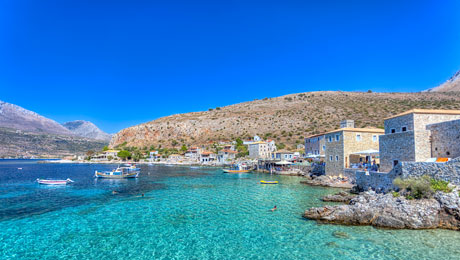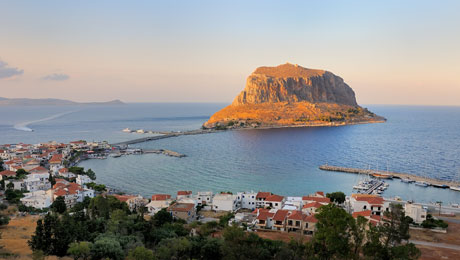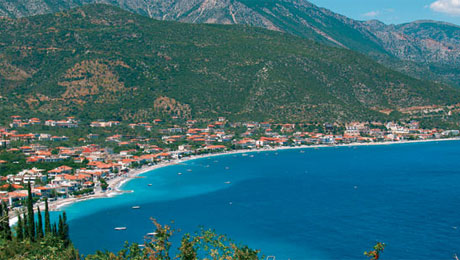A village in Mani
The Peloponnese is the largest peninsula in Greece and consists of seven areas: Achaia, Ilia, Messinia, Arkadia, Lakonia, Argolida and Corinthia. Each area enchants visitors with interesting history - from prehistoric times to the present, and each is characterised by its unique natural beauty and a variety of landscapes.
Important monuments, unique villages, picturesque towns and impressive castles, but also natural beauties, such as mountains, forests, rivers, caves, and beaches make the Peloponnese an ideal place for visitors in all seasons and for various purposes - entertainment, recreation, but also knowledge of history and culture.
Corinthia: with a strategic geographical position
We can start our tour from Loutraki, located in the first area that we will pass through upon entering the Peloponnese from Attica. The town attracts visitors from all over Greece with its famous mineral springs that originate from many places in the Bay Area, covering an area of about 750 metres. Visitors also come here for the town’s beautiful beach and vibrant nightlife.
In Corinthia, you can explore the famous Corinthian Canal, which was dug in 1880-1893 and links the Corinthian and Saronic Gulf. You can also visit Akrokorinthos with its impressive fortress, the Temple of Aphrodite and beautiful view.

Going further to the west to the city of Patras, you will pass through beautiful small villages and cities with clean beaches, such as Vrahati, Derveni, Kiato and Xilokastro, which are some of the most famous resorts of the Peloponnese.
Achaia: "The gate" of Greece to Europe
Achaia is one of the areas of the Peloponnese boasting rich history. It represents the "sea gate" of Greece to Europe. Upon entry into the area, you will go through Akrata, Diakoptó and Egio, the second largest city in Achaia. This is a beautiful city with a long history, built amphitheatrically, with a magnificent view over the Corinthian Gulf. Egio visitors will find the old town and the beach particularly interesting - from the train station to the church of the Virgin Mary, as well as old warehouses for raisins, which have now been renovated and turned into cafes.
Just before you reach Patras, you will see the spectacular bridge connecting the Peloponnese with mainland Greece - Rio Andirio, which was built in 2004.

Patras - the capital city of Achaia, with the famous carnival and good mood is an important port, and is worth a visit in order to explore the medieval castle, the famous "Achaia Claus" winery, the impressive church of St. Andreas and the new Archaeological Museum.

Patras
If you continue west, you will pass through small coastal villages with beautiful beaches, such as Lakopetra and Kalogria, as well as through the unique Strofilia pine forest.
Ilia: endless sandy beaches
If you continue southwest, you will reach Amaliada, the second largest city of the Ilia region, with numerous archaeological monuments and sites.
You will encounter a lot of large and impressive sandy beaches along the way, such as those at Killini and Kourouta, as well as Lake Kaiafas, which was declared a nature reserve and is a centre of spa tourism in the region.

Lake Kaiafas
Pyrgos, the capital city of the region was especially developed at the time when raisins were actively grown here (19th century - 1930), thanks to its geographical position.
Near Lake Kaiafas, you will find the town of Zacharo, which ends with a beautiful wide sandy beach. The surrounding area is lush, there are many olive and pine trees, and not far from it you can visit the beautiful Neda Gorge and Ancient Olympia.
Messinia: olive groves, blue-green sea and historical monuments
Kyparissia, with its traditional village in the Old Town and impressive castle, endless olive groves, blue-green sea, historical monuments and natural beauty, is a place that enchants every visitor.
You can feel the beauty of the Messinia region in the picturesque town of Pylos, embraced in Navarino Bay. This is a lovely coastal town with bright island colours and the famous fort, towering at the harbour entrance.

Pylos
The beautiful towns of Methoni and Koroni are located at both ends of the first finger of the Peloponnese, with famous Venetian fortresses, sandy beaches and interesting sights in the surroundings. The capital of the Kalamata region is also an interesting destination, famous for its beautiful landscapes and attractions, as well as its local products, which are an essential part of the Mediterranean diet.
Kardamili and Stoupa in the western part of the second finger are two villages with wonderful beaches and crystal clear waters and many natural beauties.
Lakonia: original traditions and beaches
The towns of Itilo and Areopoli on the Mani Peninsula will enchant you with their wild scenery, as well as their picturesque and traditional character. The area has many hiking trails, 67 stone villages built in a traditional style, fortresses, Byzantine and post Byzantine churches with unique frescoes and towers, as well as unique flora and fauna.

South of Areopoli, in the Gulf of Diros, in the subsurface of Glyfada cave, visitors will enjoy unique beauties. Glyfada ranks among the three most beautiful lake caves in the world. Further south, interesting villages in the traditional style are worth visiting, such as Gerolimenas with the picturesque natural port, Vathia, with stone towers overlooking the sea and Porto Cayo (Port aux Cailles), which is a picturesque village where migratory quails used to take a rest during their long journey to warmer climates. The village is named after them.
Opposite the second finger of the peninsula and a little further north, you can find the historic town of Gythio located amphitheatrically at the foot of Mount Akoumaros, where you can also find beautiful beaches. You will see beautiful neoclassical houses and immerse yourself in the intense life of the town. A small isthmus connects the southern end of Gythio with a tiny island - ancient Kranai or Marathonisi. On this island, according to mythology, Paris and Helen spent their first night before leaving for Troy.
Sparta, the capital city of the LaKonia region, is located on the mainland Peloponnese and is a city with interesting attractions and a starting point for excursions amid the beautiful scenery in the area.
The medieval fortified town of Monemvasia is located on the third finger of the Peloponnese, with its fairy-tale scenery of rare beauty and many cultural influences. They call it the "Gibraltar of the East" because of its resemblance to the Strait of Gibraltar.

Monemvasia
The beautiful island of Elafonissos is also located in the region of Lakonia, famous for its unique beaches, dunes and the typical tree species Juniperus macrocarpa (Large-fruited Juniper).
Arcadia: the heart of the Peloponnese
The greater part of Arcadia is a continental area and includes mountainous and other beautiful landscapes. The town of Leonidio is located near the coast of the province. The town which was built in the traditional style boasts an impressive landmark: the red rock overlooking it.
If you continue northwards, you will find numerous picturesque creeks and beaches. Further on, you will get to the resort town of Tiros, which consists of Ano Tiros, on the slopes of Parnonas, Kato Tiros, a bit further down, and the beach of Paralia Tirou.

Tiros
Astros town in the northern coastal part of Arcadia offers a relaxed boat trip to the picturesque harbour and walks along the narrow streets. There are a lot of taverns and restaurants on the promenade. Here, in the spring of 1823, the Second National Assembly of Greeks was convened.
Argolida: with ancient history and "heavy" heritage
At the end of our tour of the Peloponnese, we will reach the Argolida region and the city of Argos, one of the oldest cities in Greece, which is an infinite "museum" with its many unique finds dating from various eras. Here you will also find modern places of interest and plenty of opportunities for recreation and entertainment.
The capital city of the province, Nafplio, is one of the most beautiful Greek cities, and was the first capital city of the newly established Greek state. Your visit to Nafplio will not be complete without climbing up to the Palamidi fortress in order to enjoy the scenery. You should also take a walk in Akronafplia, which was the acropolis of Nafplio in ancient times. If you visit Nafplio during the weekend and the weather is nice, you will have the chance to visit the nearby island by boat, where you will find the small picturesque Bourtzi fortress.

Nafplio
A few kilometres from the city, there are great beaches and fishing villages that have become tourist resorts, such as Tolo, Vivary, Porto Heli, Ermioni and others.
In addition, from Nafplio you can easily reach all the archaeological sites in the Argolida region, such as Mycenae, Epidaurus, etc., and enjoy routes that pass through mountainous and coastal areas.